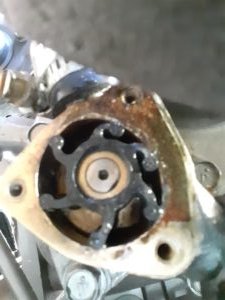Spring, where we live, always comes in fits and starts. Last month I wore shorts to work; two days later it was back to flannel-lined trousers. The day after we went canoeing for the first time, I numbed my fingers in the breeze at the top of a mast. The urgency to get boats ready for the season on fine days is tempered by the realization, on cool days, that it doesn’t really get warm until June.


Still, June is approaching fast, and the wise New Englander knows that to seize a good day to get some boat prep done is more important than to regret the bad days that keep him under hatches. I was able to seize many such days in the last few weeks, with the happy result that the tiny schooner is just about ready to launch.



The rig got pretty thoroughly gone over during winter: masts varnished; tabernacles painted; new standing rigging. The gaff jaws proved the biggest problem: they were too small, and had chafed a groove in the masts where they rested. Unable to live with that, I cut their openings bigger, then reinforced them with epoxy and carbon fiber, and finished them off in leather. Now, while everything seemed to fit together while lying on its side on the shop floor, the real test would come when I could actually put it all on the boat.

That, of course, required pulling the schooner out of the shed that had kept it nice and dry, but doing that allowed me to do some necessary tidying up—it’s amazing how scrap wood and things just pile into drifts when you don’t shake them up from time to time. Parked next to Ganymede, and away from the winter clutter, she looked bigger, and brighter, and full-er of promise.

The rig dry-fit, with only minor tweaks, was a success; to sort the lengths for sheets and halyards was the work of only a few moments. I used my favorite boat rope: New England Ropes’ “Regatta Braid.” I’ve used it since day One on Ganymede, and some of her line, after a decade and 12,000+ sea miles, is still the original. It’s soft; it’s supple; it splices well, ages well, and it’s very economical. That last item was important, because even on a boat as small as a 20-foot schooner I used close to 400 feet of it.
Another thing I could now do was to jack the boat off the trailer, roll the latter out from under, and inspect the centerboad. It was mostly in good shape, except that the wire pennant, which had been exopy-potted into the attachment point of the board, had also been cut too short to allow full deployment. With a sigh I drilled and ground and cut the wire out, then glassed in a nice repair with a replaceable attachment point. The new pennant is Dyneema: I’ll go back to wire if there’s too much chafe, but now switching will be easy, even under water.

Before placing the boat back on the trailer we applied some Kirby’s antifouling—black, to match the eagle figurehead. A good coat of McCloskey’s varnish on all the exterior woodwork, and we could turn to the final item: making sure the engine and electrical were all spiffy. The original batteries were shot, so I had just bought new ones. As well as the original bilge pump I installed a second one with a float switch, in case water gets in while we’re away, and a small solar panel to keep the batteries nice in case the bilge pump needs to run.

Not trusting to those alone I installed a Whale Titan manual bilge pump as well—you just don’t want to take chances with a fifty-year-old plywood boat, and who knows what sort of seams will open up when we get into some waves.
The hardest part was putting in a new impeller wheel for the engine cooling. The housing was out of sight under the alternator and hard by a bulkhead. I wound up having to snake a phone in there from below, snap a picture to see what was going on, feel my way through the next step, and snap another picture. Four hours later it was done, though. I shudder to think of ever doing that in a seaway over a hot engine—but hopefully I won’t have to.

I said the engine and electric were the final item, but there’s still one more thing to be done, and it’s proving even harder than the impeller. To get a boat registered, the Powers that Be require not only proof that you actually own the boat, but that the person handing it off to you also owned it. With a homemade plywood hull and no identifying markers, it gets tricky. With all the illegal plywood boats out there, coming from goodness-knows-where, you can understand the Law’s desire for a paper trail. But that paper trail is challenging to discover, especially when it leads across four different New England states and spans five decades. Still, we’re slowly teasing it out, and if all goes well, we’ll have her in the water before summer gets too hot.
